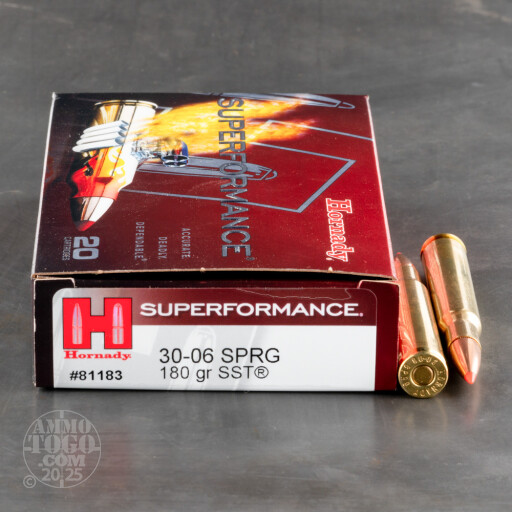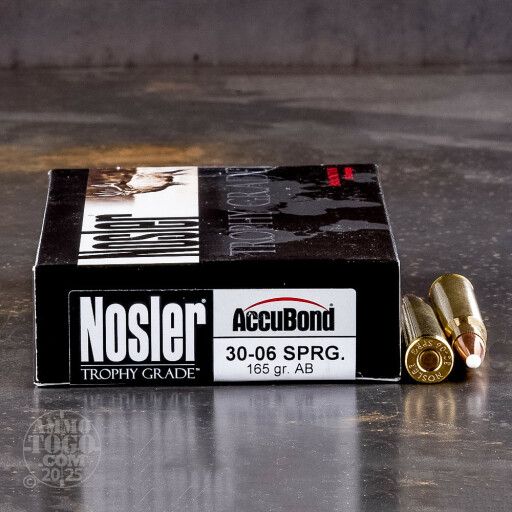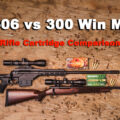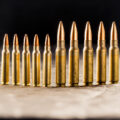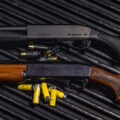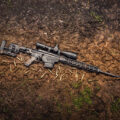Our picks for the best 30-06 ammo options for elk hunting and why 30-06 is still a capable cartridge for elk.
The .30-06 Springfield is over a century old. Once the preferred cartridge of elk hunters, the .30-06 is slowly falling out of favor. Today’s hunters seem to prefer faster, fancier, more modern cartridges like 6.5 Creedmoor. That said, there are plenty of 30-06 ammo options that are great fits for your next elk hunt.
Top 30-06 Ammo for Elk Hunting
If you’re looking for a solid .30-06 factory load for your next elk hunting trip, stick to loads with heftier expanding bullets, preferably 165 grains or heavier. Here are a few of our favorites.
Hornady Superformance
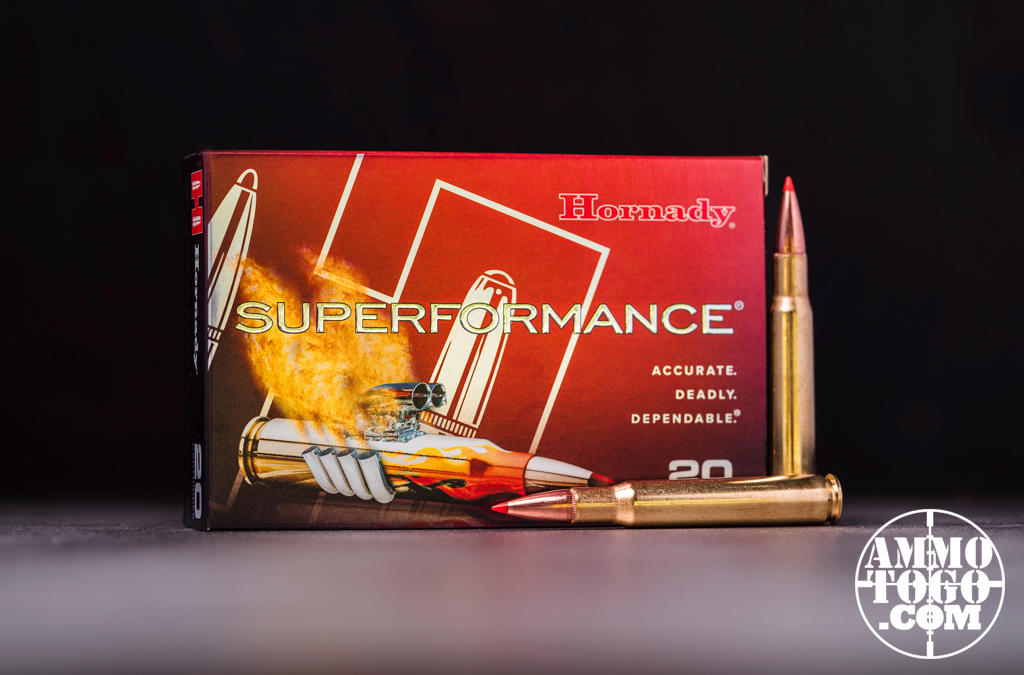
The Hornady Superformance line is just plain impressive. The company uses top-notch brass, progressive propellants, and cutting-edge bullet designs.
Across the board, Superformance .30-06 loads are proven elk-droppers. When topped with Hornady’s proven SST and interlock projectiles, these loads crush through bone and carve through soft tissue for quick, humane kills.
The company recently expanded the Superformance line to include their new, innovative CX projectile. These exciting monolithic copper-alloy bullets are topped with a heat-resistant polymer tip to keep ballistic performance consistent. These loads are designed to extend your effective range and drive deep into vitals once they find their mark.
Nosler Trophy Grade
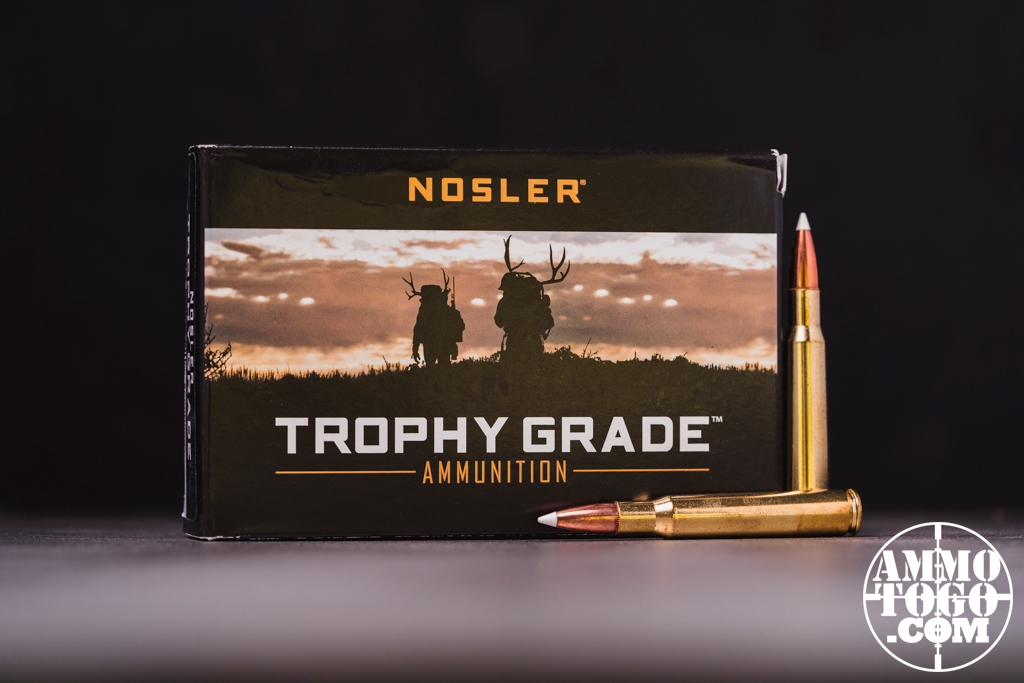
Loaded with Nosler’s legendary AccuBond bullets, Trophy Grade ammo is pretty darned good at making meat out of standing elk. AccuBond projectiles feature a unique white polymer tip that improves in-flight performance and on-target accuracy. These bullets also have a boattail base that acts as a supporting platform for monstrous mushrooming.
Barnes VOR-TX LR
Designed for long-precision and devastating terminal performance, VOR-TX LR features Barnes’ exclusive premium all-copper bullets. These unique projectiles are made with a polymer tip and a boat-tail base for impressive in-flight performance. The accuracy of these projectiles rivals some factory match loads.
VOR-TX bullets also expand reliably at closer ranges, making them a highly versatile option for elk hunters. On target impact, the polymer tip drives backward into the bullet nose to initiate expansion. Instead of a solid mushroom, VOR-TX bullets form four outward-opening metal petals that slice through soft tissue like a hot knife through butter.
Remington Core-Lokt
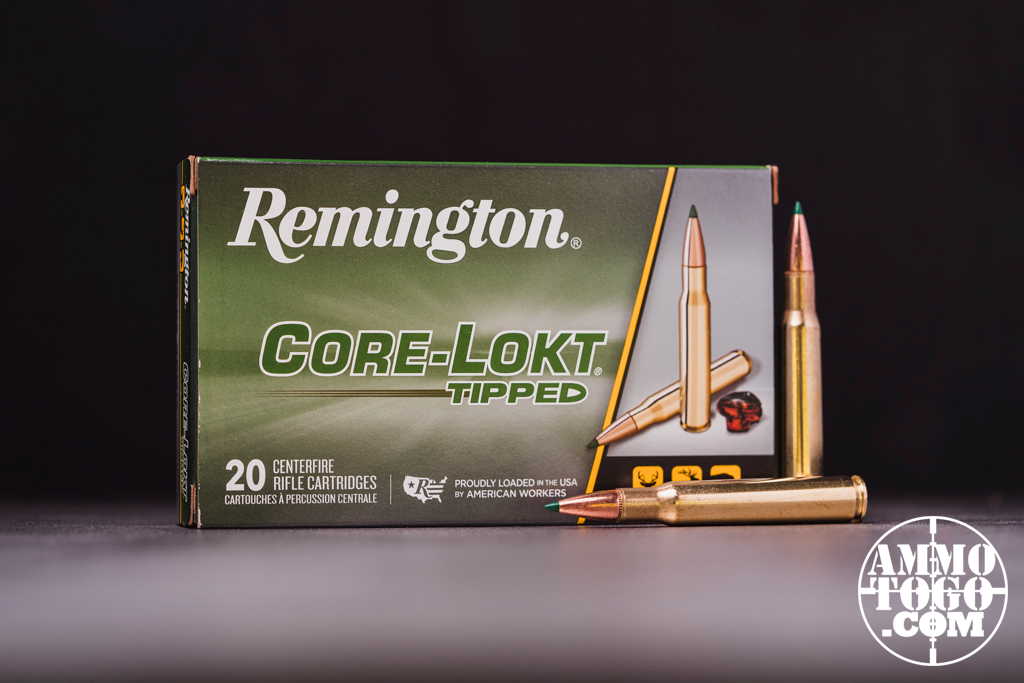
Fancy, modern loads are nice, but Remington Core-Lokt is a time-tested, tried-and-true game getter. The original controlled expansion bullet, Core-Lokt soft points are simple but highly effective.
These bullets feature a tapered copper jacket locked to a solid lead core. The design delivers mammoth mushrooming, impressive weight retention, and consistent terminal performance.
Choose the 180-grain pointed soft points version of Remington Core-Lokt for better long-range performance.
A Brief History of the .30-06 Springfield
The .30-06 Springfield (pronounced “thirty aught six”) was built for war. It was released by Springfield Armory and the United States military in 1906, which is what the -06 stands for. It was used in US military service until the mid-1970s when it was replaced by the 7.62×51mm NATO ( which is more or less the military version of the .308 Winchester).
The .30-06 Springfield saw combat in several wars, including World War I, World War II, the Korean War, and the Vietnam conflict.
The cartridge was perfect for combat applications. Its simple design fed smoothly in both bolt-action and semi-auto rifles. It delivered impressive ballistics for the time period, was consistently accurate, and produced lethal on-target performance.
On the home front, .30-06 became the sweetheart cartridge of outdoor sportsmen. The same qualities that made the cartridge deadly on the battlefield made it deadly in the deer woods. Servicemen returning from war were intimately familiar with the cartridge and the rifles that fired it, which certainly contributed to its popularity in the civilian world.
Despite dozens of newer, faster cartridges that have hit the hunting scene in recent years, the .30-06 Springfield remains a top seller, and not just because your dad and grandad loved it. This cartridge still has all the qualities that earned Grandad’s respect, and with modern advances in ammo technology, the .30-06 has never had more to offer serious elk hunters.
How the .30-06 Measures Up
The .30-06 earned its hunting cred as a deer cartridge. But does it have enough oomph for elk?
Elk can be three to four times larger than even the largest whitetail buck. Rocky Mountain bull elk are some of the toughest hooved game animals on the North American continent. Mature bulls are not only large, but they also have heavy bones, thick muscles, and serious resilience.
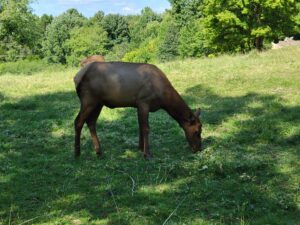
Also, shots on elk can be far.
A 180-grain bullet fired from a .30-06, carries plenty of terminal energy to bust through heavy bone and thick muscle, especially at typical hunting ranges. And with modern propellants and streamlined projectiles, the .30-06 stretches well beyond what it could in Grandpa’s day.
But how does the .30-06 compare to today’s chic hunting cartridges like .308 Winchester, .300 Win Mag, or even the current poster child of long-range shooting, the 6.5 Creedmoor? Let’s look at the data to see if this antiquated cartridge can still hold its own.
What a hunter considers will differ based on his or her needs and personal preference. That’s why cartridge debates will always rage around campfires. That’s also why we’re going to look beyond this cartridge’s ballistic capabilities. Although, that seems like a pretty good place to start.
External Ballistics
How a bullet behaves between leaving the muzzle and striking the target is referred to as “external ballistics.” For serious long-range shooters, there is no more important factor than external ballistics (that’s for shooting, not necessarily hunting. We’ll get to other important stuff in a minute).
The faster a bullet leaves the muzzle and the higher its ballistic coefficient, the flatter it will shoot. Rapid-moving, high BC bullets also resist wind better and retain more energy as they travel downrange.
Of course, the biggest factor in accuracy isn’t the bullet at all. It’s the person holding the rifle. No cartridge/rifle combination will magically make up for poor marksmanship skills.

That being said, .30-06 has been used to win plenty of short, medium, and long-range target competitions.
Famed Marine sniper, Carlos Hathcock II, used the .30-06 to achieve some amazing feats of long-range accuracy. Best known as the “White Feather Sniper,” Hathcock made his second-longest confirmed shot (1200 yards) with his .30-06 Springfield rifle. He also used a .30-06 to win the 1965 Wimbledon Cup.
But that was in 1965. How does .30-06’s external ballistics compare to other popular big game hunting cartridges? Let’s take a look.
External Ballistics Comparison Chart
| Cartridge | Bullet Weight | Ballistic Coefficient | Muzzle Velocity | Inches of drop
300 yards |
Inches of drop
400 yards |
Inches of drop
500 yards |
| 6.5 Creedmoor | 143 grain | .625 | 2700 fps | -3.2 | -16.3 | -37 |
| .270 Win | 150 grain | .525 | 2850 fps | -2.3 | -14 | -33 |
| .308 Win | 165 grain | .490 | 2750 fps | -3.4 | -16.9 | -38.6 |
| .30-06 Sprg | 165 grain | .490 | 2950 fps | -1.8 | -13 | -31 |
| 7mm Rem Mag | 162 grain | .630 | 3000 fps | -0.8 | -10.5 | -26 |
| .300 Win Mag | 180 grain | .510 | 3050 fps | -0.8 | -10.8 | -27 |
When compared to the trajectory of other popular elk cartridges, the .30-06 definitely holds its own, outperforming everything on this list that isn’t a magnum load. While you might not describe the .30-06’s trajectory as pancake-flat, its performance isn’t all that far off from magnum cartridges with their extra propellant and power.
Terminal Ballistics
Terminal ballistics is how the projectile behaves once it strikes the target. Sometimes referred to as “knock-down power”, terminal energy is the amount of kinetic energy the bullet transfers to the target.
“Knock-down power” is an almost mythical stat. Although it sounds cool, it’s mostly a number that ammo manufacturers use to sell their products.
The problem with using terminal energy to determine a cartridge’s value as a hunting round is that energy transfer isn’t what drops big game animals (or even small game animals for that matter). Bullets kill animals because they rip through soft tissue, perforate vital organs, and create massive blood loss.
Bottom line? Blood loss kills bull elk, not kinetic energy. (At least in most cases. We all know that one guy who brags incessantly about his “dead right there” kill from a shot to the spinal cord. I know I’ll get hate mail over this, but those are usually lucky shots.)
However, I’m going to (begrudgingly) add the terminal energy stats here, because there are plenty of hunters who swear by them, hand on the Bible and everything.
Plus, terminal energy can affect penetration, and deep penetration with a well-placed shot can lead to increased blood loss. And increased blood loss kills big bulls.
Terminal Energy Comparison Chart
| Cartridge | Muzzle energy | Terminal energy
300 yards |
400 yards | 500 yards |
| 6.5 Creedmoor | 2315 ft/lbs | 1658 ft/lbs | 1475 ft/lbs | 1308 ft/lbs |
| .270 Win | 2706 ft/lbs | 1831 ft/lbs | 1595 ft/lbs | 1383 ft/lbs |
| .308 Win | 2771 ft/lbs | 1809 ft/lbs | 1554 ft/lbs | 1329 ft/lbs |
| .30-06 Sprg | 3189 ft/lbs | 2108 ft/lbs | 1821 ft/lbs | 1565 ft/lbs |
| 7mm Rem Mag | 3238 ft/lbs | 2359 ft/lbs | 2113 ft/lbs | 1888 ft/lbs |
| .300 Win Mag | 3719 ft/lbs | 2514 ft/lbs | 2190 ft/lbs | 1900 ft/lbs |
If we’re judging on terminal energy alone, all of these cartridges pack a hard enough punch to drop a mature bull out to 500 yards. Even at 500 yards, the .30-06 delivers well above average performance.
Recoil
It isn’t fair to discuss terminal energy without also mentioning recoil.
As our friend Sir Isaac Newton so eloquently put it, “For every action, there is an equal and opposite reaction.”
Because these hefty loads are pushing forward with so much energy, the law of physics requires just as much energy to be pushed back. That backward pushing energy is recoil.
There are a ton of variables that affect recoil, including the weight of your rifle, the weight of the projectile, the velocity of the bullet, and individual perceptions (smaller people tend to be more affected by recoil).
Magnum cartridges (like .300 Win Mag) deliver a ton of power, but that performance isn’t free. It comes with a ton of felt recoil.
While some hunters say you should just “suck it up,” excessive recoil can have a serious negative effect on shooting. A hunter who is scared of his rifle, won’t be able to line up steady crosshairs and pull the trigger with confidence.
Recoil has even worse effects on follow-up accuracy. Recovery from a hefty recoiling rifle can take some work. Muzzle rise and a pounding shoulder can make it difficult to get back on target quickly.
More important than finding a cartridge with impressive terminal energy numbers is finding one with recoil you can manage well. A well-placed bullet is ultimately far more important for punching an elk tag than a poorly placed bullet fired from a cartridge with impressive stats.
When it comes to recoil, most shooters consider the .30-06 fairly manageable. The best way to see how you can handle it is to shoot it. But because we like to see things on paper, here’s how the recoil of these cartridges compares by the numbers.
Recoil Comparison Chart
| Cartridge | Bullet weight | Recoil Energy | Recoil Velocity |
| 6.5 Creedmoor | 143 grains | 12 ft/lbs | 9.9 fps |
| .270 Win | 150 grain | 18.9 ft/lbs | 11.7 fps |
| .308 Win | 165 grain | 18.1 ft/lbs | 12.5 fps |
| .30-06 Sprg | 165 grain | 20.1 ft/lbs | 12.7 fps |
| 7mm Rem Mag | 162 grain | 20.3 ft/lbs | 12 fps |
| .300 Win Mag | 180 grain | 25.9 ft/lbs | 14 fps |
Cost and Availability
Nearly every major ammo manufacturer loads .30-06. Most offer more than a dozen iterations featuring everything from lightweight spitzers to hefty round nose soft points. There is plenty of variety and no shortage of elk-worthy loads to choose from.
The abundance of options also means it’s usually easy to get your hands on .30-06 ammo. The only time I’ve ever walked into a sporting goods store and not seen several varieties of .30-06 ammunition on the shelves was during the Great Ammo Shortage of 2020. (Those were sad times.)
.30-06 ammo also tends to be plenty affordable, especially when compared to boutique loads. For example, you’ll spend about 25 cents more per round for Hornady Superformance in 6.5 Creedmoor than you will for .30-06 Superformance. Of course, you can find plenty of options in-stock now when it comes to 30-06 ammo for sale at AmmunitionToGo.com.


